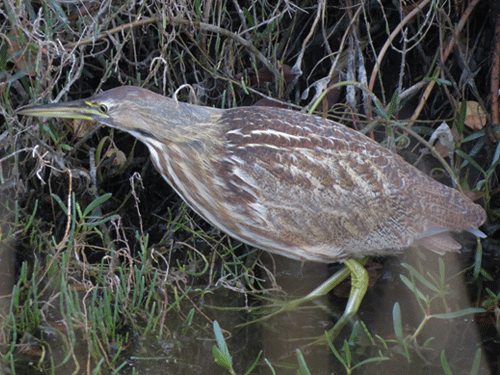During January I found 61 species at Gemini Springs, beating my previous high species count of 58 from December 2011. The complete list is at the bottom of this post.

Wood Stork; January 2 2012
New birds for me at the park included Hooded Mergansers and Blue-winged Teal (ducks, finally!).

dusk; January 6 2012

Little Blue Heron; January 6 2012

Great Egret; January 6 2012
I started regularly walking a different part of the trail on the west side of DeBary Bayou and found a few birds to be quite predictable there: Belted Kingfisher, Eastern Phoebe, Eastern Bluebird, and Bald Eagle. I had seen the eagle from the paved trail on most previous visits (from his high perch he was hard to miss!) but the others were only visible when taking the new patch of trail.

Eastern Phoebe; January 6 2012

Eastern Bluebirds; January 12 2012

Bald Eagle; January 15 2012

Northern Mockingbird; January 16 2012

apparently raided turtle nest; January 16 2012
Arthur and I went kayaking in the bayou on January 17th and saw at least three American Bittern plus just tons and tons of herons, egrets, and ibises.

bayou trash; January 17 2012

Red-shouldered Hawk; January 18 2012

White-eyed Vireo; January 18 2012
On January 21st I visited the park for over four hours and explored a new trail I hadn’t walked before. There I found another new bird: Blue-headed Vireo. This part of the trail seemed quiet and as I watched a small mixed flock of warblers and vireos foraging in some trees, I imagined that the part of the park I was in wasn’t visited very often. Just then a group of three mountain-bikers came along the rough trail and surprised me. There are still parts of the park I haven’t visited. I’m glad there are still new spots to explore. Though even the “old” parts hold the mysteries and magic of the great outdoors.

Savannah Sparrow; January 21 2012

kayaks on the bayou; January 21 2012

Common Gallinule; January 21 2012

Pied-billed Grebes; January 21 2012

Limpkin with apple snail; January 21 2012

woo hoo, a new bike rack; January 21 2012
January bird list, Gemini Springs
Blue-winged Teal – Anas discors
Hooded Merganser – Lophodytes cucullatus
Pied-billed Grebe – Podilymbus podiceps
Wood Stork – Mycteria americana
Double-crested Cormorant – Phalacrocorax auritus
Anhinga – Anhinga anhinga
American Bittern – Botaurus lentiginosus
Great Blue Heron – Ardea herodias
Great Egret – Ardea alba
Snowy Egret – Egretta thula
Little Blue Heron – Egretta caerulea
Tricolored Heron – Egretta tricolor
Cattle Egret – Bubulcus ibis
Green Heron – Butorides virescens
White Ibis – Eudocimus albus
Glossy Ibis – Plegadis falcinellus
Black Vulture – Coragyps atratus
Turkey Vulture – Cathartes aura
Osprey – Pandion haliaetus
Bald Eagle – Haliaeetus leucocephalus
Cooper’s Hawk – Accipiter cooperii
Red-shouldered Hawk – Buteo lineatus
Common Gallinule – Gallinula galeata
American Coot – Fulica americana
Limpkin – Aramus guarauna
Sandhill Crane – Grus canadensis
Forster’s Tern – Sterna forsteri
Mourning Dove – Zenaida macroura
Belted Kingfisher – Megaceryle alcyon
Red-bellied Woodpecker – Melanerpes carolinus
Downy Woodpecker – Picoides pubescens
Pileated Woodpecker – Dryocopus pileatus
Eastern Phoebe – Sayornis phoebe
White-eyed Vireo – Vireo griseus
Blue-headed Vireo – Vireo solitarius
Blue Jay – Cyanocitta cristata
American Crow – Corvus brachyrhynchos
Fish Crow – Corvus ossifragus
Tree Swallow – Tachycineta bicolor
Carolina Chickadee – Poecile carolinensis
Tufted Titmouse – Baeolophus bicolor
Carolina Wren – Thryothorus ludovicianus
House Wren – Troglodytes aedon
Blue-gray Gnatcatcher – Polioptila caerulea
Ruby-crowned Kinglet – Regulus calendula
American Robin – Turdus migratorius
Gray Catbird – Dumetella carolinensis
Northern Mockingbird – Mimus polyglottos
Black-and-white Warbler – Mniotilta varia
Orange-crowned Warbler – Oreothlypis celata
Common Yellowthroat – Geothlypis trichas
Palm Warbler – Setophaga palmarum
Pine Warbler – Setophaga pinus
Yellow-rumped Warbler – Setophaga coronata
Chipping Sparrow – Spizella passerina
Savannah Sparrow – Passerculus sandwichensis
Song Sparrow – Melospiza melodia
Northern Cardinal – Cardinalis cardinalis
Red-winged Blackbird – Agelaius phoeniceus
Common Grackle – Quiscalus quiscula
Boat-tailed Grackle – Quiscalus major









































































